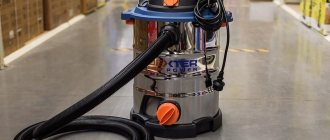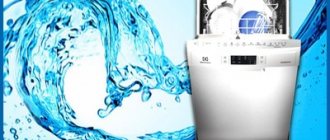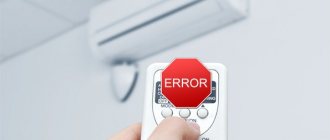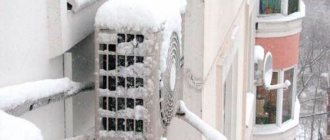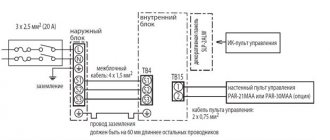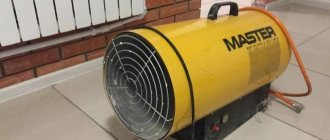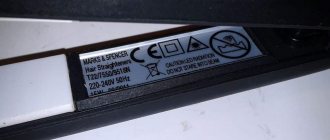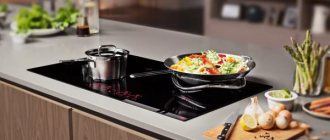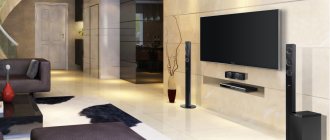Air conditioners and split systems with FREE installation
People often think that an air conditioner “eats” a lot of electricity. They believe that a 2.5-kilowatt system consumes the same amount per hour. This is not a heater, and the numbers are different.
A split system only needs electricity to operate the compressor and fan. Therefore, it consumes less electricity.
How much electricity does an air conditioner consume per hour?
There is a formula for calculation: the rated power of the split system divided by the EER coefficient. All this data is indicated in the instruction manual.
EER indicates how many times a device's power consumption is lower than its performance. The coefficient depends on the energy efficiency class. Most modern systems have class A, which corresponds to EER >3.20.
For example, the cold performance of an air conditioner is 2.5 kW, class A. We calculate its consumption per hour: 2.5 / 3.20 = 0.78 kilowatts.
Roughly speaking, a split system spends three times less than it produces. Therefore, to the question of how much an air conditioner consumes, the answer will be as follows:
- “sevens” – 0.65-0.75 kW/h;
- “nines” - about 0.78-0.88 kW/h;
- “twelve” - 0.96-1 kW/h.
Please note that the system does not operate continuously. When it reaches the desired temperature, it will turn off.
If the model is inverter, when the specified parameters are reached, the compressor will reduce speed to a minimum without turning off. Maintaining the temperature requires less energy than full cooling.
Manufacturers of inverter air conditioners claim that their devices consume 40% less electricity than conventional models. Thus, the inverter “nine” consumes approximately 500 W per hour.
More details Maintenance of air conditioners Price from 2,500 ₽
Air conditioner energy efficiency classes
The energy efficiency class of the air conditioner is indicated in the technical data sheet by the value COP - heating mode and EER - cooling.
Energy efficiency classes of split systems:
- A – COP – 3.60, EER – 3.20.
- B – COP – 3.40/3.60, EER – 3.20/3.00.
- C – COP 3.20/3.40, EER 2.80/3.00.
- D – COP 2.80/3.20, EER 2.60/2.80.
- E – COP 2.60/2.80, EER 2.40/2.60.
- F – COP 2.40/2.60, EER 2.20/2.40.
- G – COP 2.40, EER 2.20.
Which energy efficiency class is better?
Air conditioners of classes A, A+, A++, A+++ are considered energy efficient, the coefficient of which is equal to or higher than 3.2.
As a rule, the higher the class, the more rational the energy consumption. Such devices are more expensive, but they are more economical to operate.
Precision air conditioners: types, installation, maintenance
How much does an air conditioner consume per month?
It all depends on the number of hours worked. If the weather is hot, the device can work up to 10-12 or more.
Let’s take the same “nine” as an example. An hour of operation requires 0.78 kW. In 6 hours, consumption will reach 4.68 kilowatts per day. In a month it will generate 140 kW when operating in this mode. If we take into account the tariff of 5.38 rubles for 2021, in rubles the figure will be an additional 753 rubles. per month.
This calculation is quite rough. It all depends on the area of the room, heat flow, desired parameters in the room, etc.
kW consumption calculations
Let's take an air conditioner (07) with a power of 2000 Watts, which means that it consumes 700 - 800 W/hour depending on the mode: heating or cooling the air, but if the air conditioner has an inverter compressor, then the consumption will decrease by another 30-50% and will be 350- 500 W/hour.
We recommend: Checking the cold or hot water meter
Calculation of consumption for 1 minute: 500 (device power) / 60 (minutes in an hour) = 8.3 Watts/minute.
Let's say that you turn it on for 9 hours a day: 500(consumption per hour) * 9(number of operating hours) = 4500 W (4.5 kW/day).
Electricity consumption per month: 30 (days of operation) * 4.5 (consumption per day) = 135 kW/month.
The amount of payment for the electricity spent by the air conditioner: 135 * 3.5 rubles (for example, the tariff for 1 kW/hour, there are different tariffs in each region, district, city and village) = 472.5 rubles.
Attention, we calculated the consumption of a type 07 air conditioner with an inverter compressor for a 9-hour working day (in hot weather it can work for 18 hours and then the consumption will increase by 2 times), if you have the same type, but without an inverter, then the consumption will be 5, 85 kW per day, 175.5 kW per month.
How to reduce the electricity consumption of an air conditioner
Here are some simple ways to reduce costs:
- Choose an inverter model that consumes less electricity.
- If possible, cover windows with blinds or curtains to reduce heat gain from the sun in the room.
- Do not open windows to prevent hot air from entering.
- Optimal parameters are 22-23 C°. Reducing the temperature by a degree increases electricity consumption by 5-8%.
- Clean the filters and heat exchanger regularly. A dirty device takes a long time to reach the desired temperature.
- Do not open the doors to the refrigerated room to prevent the cold from escaping from the room.
As you can see, installing an air conditioner does not involve huge expenses. An extra thousand a month is a small price to pay for the comfort of your own home.
Read more Service maintenance of air conditioners Price from 500 ₽ for maintenance
What determines electricity consumption?
The consumption of electrical energy using an air conditioner does not depend on its type or the presence of a heating system. The inverter type, after stabilizing the temperature, reduces the speed and maintains the temperature.
Electricity consumption depends on the set temperature, enabled functions and operating time. But here it is important to understand that an hour results in insignificant energy consumption. When it comes to costs over time, they can vary greatly.
Consumption also depends on the compressor potential (at lower speeds, less energy is consumed and the most profitable are inverter devices), the temperature difference between the street and the room (costs increase in summer heat or frost), the load of the cooling system on the split and various additional functions .
Energy Saving
The user asks a logical question about how to save energy: what can I do to pay less?
To optimize costs, you need to know what the air conditioner's flow rate is. It is impossible to predict the exact indicators of electricity consumption by a specific device over a month.
Everything will depend on various factors. On average, split systems with a power of two to three and a half kilowatts consume from half to one and a half kilowatts per hour.
Before installing an air conditioner, it is important to analyze the following parameters:
- what is the power consumption of the device, is the outlet designed for these indicators;
- what load will the electrical wiring withstand;
- parameters of meter safety plugs.
To avoid wasting money, you should choose the right device. There is a significant difference in the energy consumption of household, semi-industrial and industrial air conditioners. In addition to connection difficulties, industrial and semi-industrial air conditioners will consume several hundred kilowatts per month. While ordinary household air conditioners can cope with their responsibilities.
How to reduce energy consumption?
The actual electricity consumption when operating a split system can be significantly reduced. To do this, you should take care of the normal operating conditions of the equipment, properly care for it, and promptly prevent malfunctions that affect the power of the device.
Next, we will talk about the nuances and rules that every owner of climate control equipment should know. By following them, you can extend the life of the device, ensure its maximum efficiency and reduce energy costs.
Method #1 - buying economical equipment
If you want to purchase an economical split system model, we recommend that you pay attention to several devices from trusted manufacturers that are characterized by the lowest energy consumption.
Mitsubishi Electric MSZ-LN25VG/MUZ-LN25VG system
The inverter model of the famous Japanese brand consumes only 485 W in cooling mode and 580 W in heating mode.
At the same time, the output power is very high. The device has been assigned the highest energy efficiency class – A+++.
The device attracts with its stylish design, many advanced technologies and advanced functionality. It is equipped with the new safe R32 refrigerant, which gives it increased energy efficiency
Among the useful functions it is worth noting:
- economical night mode;
- 2-stage air filtration/disinfection system;
- wi-fi interface for remote control from a smartphone - allows you to cool/warm the room before household members arrive;
- 3D I-SEE system – scans the room, identifies the location of people, evenly distributes air masses in two directions, eliminating overheating and hypothermia of individual parts of the room; in the absence of people, the sensor automatically activates the energy-saving mode;
- Hybrid coating of the case protects against dirt and dust.
The model is distinguished by its low noise level, maintaining operability down to a temperature of -25 °C. The disadvantage of the product is its high cost - about 74 thousand rubles.
Air conditioner Panasonic CS-E7NKDW
A model from another Japanese brand costs half as much – about 33 thousand rubles. This device also runs on an economical inverter compressor with a continuously variable power control system.
The Panasonic CS-E7NKDW consumes 470 W in cooling mode and 635 W in heating mode. The technical specifications indicate energy efficiency class A+
The list of functional features of the device:
- Autocomfort sensor and Mild Dry – allow you to achieve maximum comfort in the room;
- energy-saving night mode;
- timer for setting on/off;
- automatic restart after power outages;
- Powerful mode – speeds up cooling/heating of the room.
The equipment operates quite silently and copes well with its tasks. The disadvantages are the insufficiently effective air purification system, limited temperature conditions when operating for heating - down to -5 °C.
Split system Ballu BSLI-07HN1/EE/EU
This model of the Chinese brand is one of the most budget-friendly among inverter split systems. It can be purchased at a price of 19 thousand rubles.
A split system from a Chinese manufacturer with class A energy efficiency consumes 650 W in cooling and 590 W in heating mode
Despite the budget price, the equipment is equipped with many useful functions:
- economical night mode;
- timer for setting on/off;
- self-diagnosis of emerging faults;
- preliminary cleaning of air flows;
- operational cooling of the room in turbo mode.
The minimum temperature during heating operation is -10 °C. The disadvantages of the product include noise, an inconvenient remote control, and a not very clear timer setting scheme.
Method #2 - close access to outside air
The first thing you need to do before turning on the air conditioner in order to save energy resources is to tightly close all the vents, windows and doors. If there are gaps in door or window openings that allow air to pass through, they should be eliminated if possible.
Artificial lighting devices in the apartment also serve as an additional source of heat. When using an air conditioner for cooling, it is wiser and more economical to install fluorescent and LED light bulbs in your home. An ordinary incandescent light bulb produces much more heat
On sunny days, it is advisable to lower the blinds and cover the windows with thick curtains or protective reflective film. It is especially important to follow this rule in rooms with windows facing the hot, sunny side.
Such manipulations help minimize the loss of warm or cooled air, which depends on the mode in which the air conditioner operates. As a result, the risk of redirecting most of the air conditioner's power to compensate for heat input from outside is avoided.
A device exposed to direct sunlight draws at least 5% more energy than usual.
Method #3 - choosing the right temperature
Incorrectly selected cooling temperature is the most common mistake among split system users.
The safest and most comfortable temperature range for humans is considered to be between 23-24 °C.
Sudden temperature changes are very dangerous. Frequent transitions from sweltering heat to a cold, air-conditioned room can cause a sharp decrease in immunity and disruption of the human thermoregulatory system. Therefore, when choosing a temperature regime in a split system, it is important to observe the measure
By choosing literally 3-5 values less than the recommended norm, you will jeopardize your health and force the equipment to work at maximum power. Such experiments are fraught not only with colds, but also with increased electricity consumption.
Method #4 - proper care of equipment
The technical condition of the device affects its performance. If the mechanisms are contaminated, the integrity of individual elements is damaged, or there is insufficient amount of refrigerant in the system, the power of the equipment may drop significantly. We reviewed the rules for filling the system with freon here.
The air conditioner will consume energy, but will not be able to cope with its direct responsibilities.
To avoid this, you need to properly care for your climate control equipment:
Image gallery
Photo from
Split system care
Systematic cleaning of filters and protective nets
Refrigerant quantity control
Checking the condition of connecting tubes
As you can see, any split system requires regular maintenance. Otherwise, you may encounter increased energy consumption, serious breakdowns or irreversible failure.
We recommend that you familiarize yourself with the features of self-service of split systems.
Method #5 - ensure proper operation
Each split system is designed to operate in a certain temperature range. This nuance must be clarified before purchasing. You can view the information in the instructions included with the product.
After installing the split system, it is important to ensure free access of air to the indoor and outdoor units. Obstructions reduce equipment efficiency and increase energy consumption
Permissible operating temperatures must not be violated, otherwise the efficiency of the device will drop sharply. If the minimum recommended temperature for using the device in heating mode is -5 °C, then it should not be turned on when it is colder outside.
To heat rooms in cold weather, there are special models of split systems. In such conditions, they will use electricity more efficiently.
Is it expensive to maintain an air conditioner?
The cost of operating an air conditioner in a detached house consists of several factors:
- electricity consumption;
- filter replacement;
- the cost of periodic inspection and cleaning of the entire installation.
The main point to start with is calculating the energy consumption of the air conditioner, because the cost of electricity will be the most significant expense for the homeowner.
Electricity costs
Electricity costs depend on the power consumption of the air conditioner. Let's take, for example, the power of a standard air conditioner, which consumes 2.5 kW/h when turned on (this type of device is used in rooms up to 25 sq. m.). This air conditioner model, operating 6 hours a day, will consume 15 kW of electricity.
How much will this cost the home owner? In the Moscow region, the cost of a kilowatt hour from 2021 on a single-phase tariff is 5.56 rubles per 1 kW/h, on a two-phase tariff - 6.39 rubles per 1 kW/h during the day, and 2.41 kW/h at night. We don’t know what tariff will be used, but it’s obvious that no one will use the air conditioner at night, so for ease of calculations, we’ll round these data closer to the upper limit and take the cost of electricity as 6 rubles per 1 kW/h.
It is easy to calculate that if you use the air conditioner only in the summer months (from June to August inclusive), turning it on for an average of 6 hours every day, the homeowner's expenses will be:
(2.5 kW/h x 6) x 6 rubles per 1 kW/h x 90 = 8100 rubles
The amount is not small, but still such a case will be typical only for a very hot summer, when every day will be clear and sunny.
Still, in the Moscow region, summer is mostly cloudy, so let's see what happens if the air conditioner turns on not every summer day, but every other day:
(2.5 kW/h x 6) x 6 rubles per 1 kW/h x 45 = 4050 rubles
Let’s say there will be not one, but three air conditioners in the house (for example, one for the living room, and one for each of the 2 bedrooms). Moreover, for the hall there will be the same air conditioner as in the examples above, and for the bedrooms - less power, consuming 1.5 kW per hour:
(2.5 kW/h x 6) + (1.5 kW/h x 6) + (1.5 kW/h x 6) x 6 rubles per 1 kW/h x 45 = 8910 rubles
That is, all electricity costs will amount to 10 thousand rubles per season. Considering that in this case several rooms of the house will be cooled at once every second summer day for 6 hours, the amount, in general, looks acceptable.
Of course, all the calculations given are approximate. In practice, these figures can vary greatly, both positive and negative, depending on the intensity of use of the air conditioner, temperature, number of sunny days, etc. Many homeowners use air conditioners not only in the summer months, but already from April-May and ending in September-October.
Another important factor is also the electricity tariff you choose and the presence of intermediaries in the chain (if you are not directly connected) or, conversely, discounts from suppliers. Although, as practice shows, a simple single-phase tariff remains the most profitable for the operation of an air conditioner (because rarely anyone uses it at night).
Costs associated with cleaning and maintaining the air conditioner
When installing a home air conditioner, you should also consider the cost of having it professionally serviced. It will be better if this is done by a qualified company that knows all the features of the installed equipment plus will provide a guarantee on spare parts and labor.
What is included in the maintenance of such devices:
- Professional diagnosis of problems;
- Cleaning the air conditioner from dust, plaque, mold and other contaminants;
- Refilling with freon and replacing filters;
- Repair and restoration of damaged / burnt out parts;
- Checking and cleaning of all blocks and drainage systems, coarse and fine filters;
- Antibacterial treatment and prevention
Cleaning and maintenance of the air conditioner should be carried out regularly: preferably at least once every 1-2 years. As a rule, homeowners order this service before the start of the summer season. The cost of such work largely depends on the specifics of the device’s operation, but on average it ranges from 2 to 4 thousand rubles per device.
Cooling power
An air conditioner is a classic example of a heat pump. Its compressor forces refrigerant to circulate through the circuit, which gives off heat in the condenser and picks it up in the evaporator. Thus, the cooling capacity of an air conditioner is the amount of heat that it takes from the room and releases it in the condenser of the external unit of the split system.
Air cooling occurs as it passes through the evaporators of the indoor unit under the influence of a fan. The air from the room does not go anywhere, and does not come from anywhere - it simply cools. Only the best air conditioners have the additional option of supplying fresh air from outside into the premises.
Technical condition of the air conditioner
The efficiency of an air conditioner very much depends on its technical condition and can sometimes drop almost to zero if the air conditioner is dirty or malfunctioning.
Air conditioner dirty
If the filters, fan and heat exchangers of the external and internal units of the split system are dirty, then the efficiency of the air conditioner decreases.
Moreover, if the pollution is very strong, then it is noticeable to the eye - the air conditioner blows “warm air”, and if it is not too strong, then no, but the air conditioner still treacherously increases the electricity meter.
The main recommendation in this case is to clean the filters more often.
Filters must be washed under running, not hot water; if necessary, you can use neutral detergents, such as dishwashing detergent.
We recommend: Artificial decorative home waterfall in the country: how to make a pond with a waterfall in the garden and in the yard from wild stone, diagram without a pump
The amount of freon in the air conditioner
The cooling efficiency of a room air conditioner also depends on the presence of freon in its refrigeration circuit.
Moreover, its quantity should be optimal for the refrigeration system.
The efficiency of the air conditioner drops both when freon leaks and when it is refilled!
The “bigger is better” principle does not apply to an air conditioner.
And even if the air conditioner cools normally, this does not mean that it is operating in its optimal mode.
The only way out for a non-specialist in this case would be to carry out regular maintenance.
Those who want to learn how to diagnose and repair an air conditioner on their own can study our constantly updated section “Do-it-yourself air conditioner repair”
Thermal insulation of copper tubes
The external and internal blocks of the split system are connected by tubes through which freon circulates; its temperature is much lower than the ambient temperature and therefore losses also occur through them.
And the longer the route, the greater the heat loss.
Thermal insulation on the tubes may not be partially applied during installation; birds love to peck at it, using it to insulate their nests, and it also loses its properties over time.
So you need to monitor the integrity of the thermal insulation and restore it.
Calculation of heated floors as the main heating
How do you know if the heat from an electric floor is enough to warm the entire room and house? To do this you need to calculate your heat loss. Of course, in each case everything is individual, and a lot of factors will influence the error.
However, you can roughly focus on the requirements of SNiP.
They say that normal heat loss for a standard residential apartment is 1 kW/h over an area of 10 m2.
At the same time, the ceiling height is a maximum of 3 m, and the walls, floor and everything else must be insulated, again in accordance with SNiP.
Let's take the same calculated data as before. Room area 20m2.
Accordingly, in such an area the heat loss will be 2 kW/hour
Your task is to block the received data. That is, you must lay mats of a certain power and on a certain area so that the final result from such installation is either equal to or exceeds the calculated heat loss of the room.
We know that the usable area that can be used for mats or heating cable in a room is 8 m2.
Based on this, we calculate what power the heated floor needs to be chosen so that it is enough to warm the room as the main source of heat.
Total for our room we have:
Ptp = 2 / 8 = 0.25 kW/m2
Moreover, if you live in a climate zone where the outside temperature can drop to -30 degrees for several days, it is recommended to add another +25% to this power.
If such a powerful mat or cable is not available, then try to increase the useful laying area and do the calculation again.
Cost of owning an air conditioner and ways to save
So, as we see, owning an air conditioner is not a cheap pleasure, but, in principle, not so expensive, considering what we get in return: coolness and comfort in our rooms during the hot summer months.
In addition, the cost of operating an air conditioner can be optimized in several simple ways:
- You can reduce the costs associated with operating your air conditioner by regularly and thoroughly cleaning the ventilation ducts. In this case, their cross-country ability will be higher, as will the cooling effect, so you will turn on the device less often, which will save on energy bills;
- Another good way to reduce costs is to seal your windows and doors and install blinds that block out strong sunlight. This way, the air-conditioned room will heat up less, which means you will use it less often;
- Another way to save money is to not open windows during the summer season. Unfortunately, many homeowners forget about this, although when the windows are open, the entire cooling efficiency of the rooms is reduced to zero. The rooms can be ventilated in the evening or morning, but during the day (in the heat) it is better not to do this and use only air conditioning;
- Another way to optimize the cost of operating an air conditioner is to slightly increase the temperature in the device’s thermostat. Remember: the lower the temperature on the thermostat, the higher the cost of using the air conditioner;
- If you have several air conditioners in your home, experts advise turning off the fans installed in the rooms while they are running. Thanks to this solution, the air conditioner will cool the rooms more efficiently, and you can save several thousand rubles a year.
Air conditioner power calculator
You can independently calculate which split system to buy and choose one that meets your requirements by using the air conditioner power calculator. The most energy-consuming process ERR is taken as the base one - the energy consumed to obtain cooling performance.
Information you need to enter into the calculator:
- Area of the room, ceiling height, whether to take ventilation into account, if so, what is the air exchange rate.
- The room is sunny or darkened, an attic or a permanent room.
- How many people work or live?
- Number of computers, televisions, total power of equipment in the room.
As a result of the calculation based on the provided information, the system will display the parameters - estimated cooling power - Q in kW and the range in which it is optimal to select the Q range air conditioner.
Using the table of power distribution of air conditioners, select the type of device, the power of the household air conditioner that is most suitable for the stated conditions.
Additional criteria for choosing an air conditioner
In addition to the power characteristics of the system and energy efficiency class, before purchasing, you should decide on the following parameters:
- type of air conditioner;
- operating principle of the unit;
- functionality;
- by the manufacturer.
Next, we will consider each of these criteria in more detail.
Criterion #1 - type of air conditioner
For domestic use, monoblocks and split systems are used. The first category includes window models and compact portable devices. Window-mounted air conditioners have lost their former popularity.
They are being replaced by more modern modifications that do not have the disadvantages of their predecessors: noisy operation, reduced illumination due to window clutter, limited choice of location
The undeniable advantages of window “coolers”: low cost and maintainability. This unit is more suitable for seasonal country use than for an apartment.
Advantages of a mobile monoblock: possibility of transportation, ease of installation. Disadvantages: large dimensions, high noise level, “binding” to the output channel
Split systems confidently occupy a leading position among household air conditioning systems.
Based on the form of execution, there are two categories of splits:
- Two-block design. A pair of modules are connected by a closed freon line. The complex is easy to operate and almost silent. Various design options for the indoor unit are available; the housing does not take up useful space in the room.
- Multi-system. The external module ensures the operation of two to five internal units.
The use of a multi-complex allows you to set different air conditioning parameters in individual rooms.
The disadvantage of the climate system is the dependence of indoor units on a single outdoor unit. If it breaks down, all rooms will be left without cooling.
Criterion #2 - operating principle
There are conventional and inverter models.
- When the temperature rises, the air conditioner turns on.
- After cooling to the designated limit, the unit turns off.
- The on/off duty cycle is repeated continuously.
But an inverter air conditioner operates more “smoothly”. After startup, the room is cooled, but the device continues to operate at reduced power, maintaining the desired temperature.
The inverter version of the split is 30-40% more economical than a conventional air conditioner. The energy efficiency EER value of some models reaches values of up to 4-5.15Due to the absence of “sharp” cyclical operation, inverter air conditioners are low noise and durable.
You also don’t know what is better to choose – an inverter or a regular air conditioner? In this case, we recommend that you familiarize yourself with their main differences, as well as the pros and cons of each option.
Criterion #3 - features and brand
Manufacturers, in an effort to win the favor of customers, equip split systems with additional options.
It’s good if the air conditioner has the following functions:
- fan distribution of air flow;
- automatic restoration of device settings;
- remote control;
- built-in timer.
Another popular air conditioner function among users is the flow of fresh air. Many manufacturers offer such models.
Air conditioners of popular brands are represented by a wide range of models in different price categories - from budget economy class to split systems in the premium segment
The equipment manufacturer plays a significant role in the choice - the better the brand reputation, the higher the quality indicators and reliability of the equipment.
The ranking of leading manufacturers is dominated by foreign companies: Daikin, LG, Sharp, Hitachi, Panasonic and General Climat. We reviewed the best air conditioner models in the following article.
Collection of initial data for calculation
To carry out calculations, you will need the following information about the building:
S is the area of the heated room.
Wsp – specific power. This indicator shows how much thermal energy is needed per 1 m2 per 1 hour. Depends on local natural conditions, the following values can be taken:
- for the central part of Russia: 120 – 150 W/m2;
- for southern regions: 70-90 W/m2;
- for northern regions: 150-200 W/m2.
Wsp - a theoretical value is used mainly for very rough calculations, because it does not reflect the real heat loss of the building. Does not take into account the glazing area, the number of doors, the material of the external walls, or the height of the ceilings.
Accurate thermal calculations are made using specialized programs, taking into account many factors. For our purposes, such a calculation is not needed; it is quite possible to get by with calculating the heat loss of external enclosing structures.
Quantities that need to be used in the calculations:
R – heat transfer resistance or thermal resistance coefficient. This is the ratio of the temperature difference at the edges of the enclosing structure to the heat flow passing through this structure. It has a dimension of m2×⁰С/W.
It's actually simple - R expresses the ability of a material to retain heat.
Q is a value showing the amount of heat flow passing through 1 m2 of surface at a temperature difference of 1⁰C in 1 hour. That is, it shows how much thermal energy 1 m2 of the building envelope loses per hour with a temperature difference of 1 degree. Has the dimension W/m2×h. For the calculations given here, there is no difference between kelvins and degrees Celsius, since it is not the absolute temperature that matters, only the difference.
Qtotal – the amount of heat flow passing through the area S of the enclosing structure per hour. Has the dimension W/h.
P – heating boiler power. It is calculated as the required maximum power of the heating equipment at the maximum difference in temperature of the external and internal air. In other words, sufficient boiler power to heat the building in the coldest season. Has the dimension W/h.
Efficiency is the efficiency coefficient of a heating boiler, a dimensionless quantity showing the ratio of the energy received to the energy expended. In equipment documentation it is usually given as a percentage of 100, for example 99%. In calculations, a value from 1 is used, i.e. 0.99.
∆T – shows the temperature difference on both sides of the building envelope. To make it clearer how the difference is calculated correctly, look at the example. If outside: -30С, and inside +22С⁰, then
∆T = 22-(-30)=52С⁰
Or the same, but in Kelvin:
∆T = 293 – 243 = 52K
That is, the difference will always be the same for degrees and kelvins, so reference data in kelvins can be used for calculations without corrections.
d – thickness of the enclosing structure in meters.
k is the thermal conductivity coefficient of the building envelope material, which is taken from reference books or SNiP II-3-79 “Building Heat Engineering” (SNiP - building codes and regulations). Has the dimension W/m×K or W/m×⁰С.
The following list of formulas shows the relationship between quantities:
- R=d/k
- R= ∆T/Q
- Q = ∆T/R
- Qtotal = Q × S
- P = Qtotal / efficiency
For multilayer structures, the heat transfer resistance R is calculated for each structure separately and then summed.
Sometimes the calculation of multilayer structures can be too cumbersome, for example, when calculating the heat loss of a double-glazed window.
What needs to be taken into account when calculating the heat transfer resistance for windows:
- glass thickness;
- the number of glasses and air gaps between them;
- type of gas between the glasses: inert or air;
- presence of thermal insulation coating of window glass.
However, you can find ready-made values for the entire structure either from the manufacturer or in the reference book; at the end of this article there is a table for double-glazed windows of a common design.
Calculation of oven energy consumption
In order to calculate the electricity consumption of an oven, how much it consumes, you need to know how often the oven is used, in what modes, for how long, what tariffs. And therefore the calculation is purely individual. Most often, ovens are purchased that consume average power, which means that their operation is 60% of the maximum, that is, 800–850 W/hour. To find out how much the oven incurs per month, you need to multiply the number of kilowatts consumed by the oven by the number of hours it operates per month. Or the amount of energy consumed hours will need to be multiplied by the average operating power (800 W). This means that thanks to this method, you can get information about how many kilowatts are consumed by the oven.
Types of electric heated floors
Today there is a huge range of electric flooring systems on the market. All of them are divided into several types.
Below we will analyze in detail the technical characteristics of each type, calculate the electricity consumption depending on the type of room per 1 m2 per hour, per month. We will also find out how the topcoat affects energy consumption.
Electrical cable
An electrical cable is a wire that is laid randomly, but more often in a “snail” or “snake” pattern. The structure is filled with a concrete screed on top, which reduces the height of the room by an average of 5 cm. The specific power of such a cable is from 0.01 to 0.06 kW/m2, its choice depends on the frequency of turns.
The energy intensity of one meter of cable ranges from 10 to 60 W. To cover 1 m2 of surface, about 5 meters of wire are required, thus heating on average requires 120 - 200 W of electricity.
Thermomat
Heating mats are a structure made of cable, which is laid according to a certain pattern on a special grid. It is often mounted under a screed and is perfect for installation in rooms with high humidity.
This model is intended for rooms with low ceilings, since the thickness of the “pie” is only 3 cm. The power of the mat is up to 0.2 kW/m2.
The average consumption per square meter of a heating mat is 120 - 200 W.
Infrared film
Infrared heated floor is a thin polymer film coated with a carbon layer. When heated, carbon emits heat.
IR film does not affect the height of ceilings. On average, about 150 - 400 W of electricity is wound to warm up 1 m2 of film.
Rod floor
Rod floor - refers to the infrared type, but instead of carbon plates it contains rods. Its energy consumption is 120 - 200 W per square meter.
